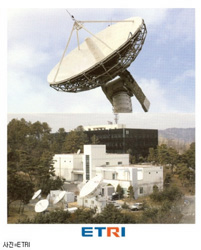Korea Envisages Global
Satellite Powerhouse
Has secured technologies related to the deployment of Arirang 2
 The multipurpose satellite "Arirang 2"that now runs in a sun synchronous orbit is likely to stay in operation for three years by using solar heat collected through the solar board.
The multipurpose satellite "Arirang 2"that now runs in a sun synchronous orbit is likely to stay in operation for three years by using solar heat collected through the solar board.
However, the satellite had to depend on hydrogen as fuel during an interval of seven minutes - from a split from the Rocket launch vehicle of Russia through the spread of the solar board. The technology for storing hydrogen, considered to be cutting-edge, is the one developed on its own by the Korea Aerospace Research Institute (KARI).
KARI officials said the technology would have far-reaching spillover effects in the case of technology transfers to the industry community as it can be applied not only to satellites, but also fuel cell cars.
The advanced technology is one of patented 37 technologies KARI has secured in the process of the development of Arirang 2.
The satellite is in orbit 695 km above the earth after it separated from the Russian launch vehicle that lifted off on July 28 from a Russian spaceport in Plesetsk,
 800 km northeast of Moscow.
800 km northeast of Moscow.
The multi-spectral camera (MSC) aboard Arirang 2 has high-resolution capacity, enough to catch an object, measuring 1 meter by 1 meter. The satellite has multiple functions including improved reconnaissance capability, gathering information on changing natural environments, disaster-hit districts and survey into the country's agriculture, fishery and forestry resources.
The deployment of Arirang2, made with many domestic technologies, is significant compared to Arirnag 1 back to December 1999 when a rocket aboard the satellite was lifted off from the United States aboard a U.S. rocket. Korea depended on the United States for all things ranging from design and manufacturing without its own technology. However, Korea played a leading role in the design of Arirang 2. U.S. commercial satellites have a 1 meter-level high-resolution capacity equivalent to Arirang 2, signaling Korea's a step closer toward making Korea a global aerospace powerhouse.
But it means Korea is still in an infant stage..
 Only 8 countries, including the United States, have technologies related to satellite launch vehicle.
Only 8 countries, including the United States, have technologies related to satellite launch vehicle.
R&D activities at KARI can be categorized into three areas: the development of cutting edge technology aircraft, the development of satellites, and the development of space launch vehicles. KARI also performs quality certification of aircraft and space products for the government.
The main programs in the area of cutting-edge technology aircraft development include the Smart Unmanned Aerial Vehicle (UAV) Development Program and the Korean Helicopter Development Program. As for satellite programs, the development of KOMPSAT-3 (Korea Multipurpose Satellite-3), KOMPSAT-5 and COMS (Communication, Ocean, Meteorological Satellite) are proceeding swiftly. In the area of space launch vehicles, basic technology enhancement programs such as the KSR-III (Korea Sounding Rocket-III) Program, which successfully test launched the liquid-fueled scientific rocket KSR-III in 2002, are being carried out continuously.
 Based on the technology acquired from these programs, present efforts are being concentrated on the development of KSLV-I, a space launch vehicle capable of launching a 100kg class small satellite into low-earth orbit, which is planned for launch in the year 2007. Construction of a space center and a launch site is also in progress and is to be completed by 2007. The completion of these programs will pave the way for Korea to become a true space faring nation.
Based on the technology acquired from these programs, present efforts are being concentrated on the development of KSLV-I, a space launch vehicle capable of launching a 100kg class small satellite into low-earth orbit, which is planned for launch in the year 2007. Construction of a space center and a launch site is also in progress and is to be completed by 2007. The completion of these programs will pave the way for Korea to become a true space faring nation.
COLLABORATION. Electronics and Telecommunications Research Institute (ETRI) said a system that controls Arirang 2 remotely from the earth was domestically developed.
The locally developed satellite control system has been successful for use in Arirang 2 following the systems used in Arirang 1.
Arirang 2 control system, developed with funds from the Ministry of Information and Communication, has technology prowess in terms of the conformity of the international satellite standard CCSDS, system automation and precision pinpointing of orbiting using GPS (Global Positioning System).
Kim Jae-hoon, chief of the Satellite Control Technology Team at ETRI, said Korea has capability in such areas as design, testing and operations with the development of the Arirang 2 control system, and the nation will be an advanced leader with excellent IT technologies.
The Arirang 2 Project has been an inter-ministry joint research project with participation by the Ministry of Science and Technology, the Ministry of Information (MIC) and Communication and the Ministry of Commerce, Industry and Energy. ETRI under the umbrella of MIC is primarily responsible for the development of the satellite control system. nw
The multipurpose satellite "Arirang 2"in a sun synchronous orbit
Paik Hong-yul, president of the Korea Aerospace Research Institute
Korea's multipurpose satellite "Arirang 2"is lifted off from a Russian spaceport on July 28.
A team headed by ETRI has developed a system that controls Arirang 2 remotely from the earth.
3Fl, 292-47, Shindang 6-dong, Chung-gu, Seoul, Korea 100-456
Tel : 82-2-2235-6114 / Fax : 82-2-2235-0799